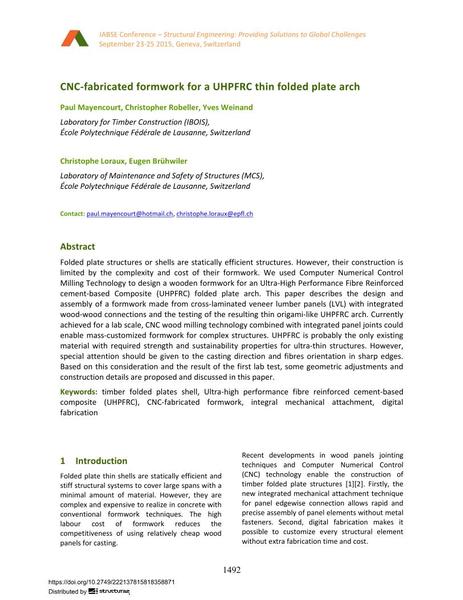CNC-fabricated formwork for a UHPFRC thin folded plate arch

|
|
|||||||||||
Détails bibliographiques
| Auteur(s): |
Paul Mayencourt
(Laboratory for Timber Construction (IBOIS), École Polytechnique Fédérale de Lausanne, Switzerland)
Christopher Robeller (Laboratory for Timber Construction (IBOIS), École Polytechnique Fédérale de Lausanne, Switzerland) Yves Weinand (Laboratory for Timber Construction (IBOIS), École Polytechnique Fédérale de Lausanne, Switzerland) Christophe Loraux (Laboratory of Maintenance and Safety of Structures (MCS), École Polytechnique Fédérale de Lausanne, Switzerland) Eugen Brühwiler |
||||
|---|---|---|---|---|---|
| Médium: | papier de conférence | ||||
| Langue(s): | anglais | ||||
| Conférence: | IABSE Conference: Structural Engineering: Providing Solutions to Global Challenges, Geneva, Switzerland, September 2015 | ||||
| Publié dans: | IABSE Conference Geneva 2015 | ||||
|
|||||
| Page(s): | 1492-1499 | ||||
| Nombre total de pages (du PDF): | 8 | ||||
| Année: | 2015 | ||||
| DOI: | 10.2749/222137815818358871 | ||||
| Abstrait: |
Folded plate structures or shells are statically efficient structures. However, their construction is limited by the complexity and cost of their formwork. We used Computer Numerical Control Milling Technology to design a wooden formwork for an Ultra-High Performance Fibre Reinforced cement-based Composite (UHPFRC) folded plate arch. This paper describes the design and assembly of a formwork made from cross-laminated veneer lumber panels (LVL) with integrated wood-wood connections and the testing of the resulting thin origami-like UHPFRC arch. Currently achieved for a lab scale, CNC wood milling technology combined with integrated panel joints could enable mass-customized formwork for complex structures. UHPFRC is probably the only existing material with required strength and sustainability properties for ultra-thin structures. However, special attention should be given to the casting direction and fibres orientation in sharp edges. Based on this consideration and the result of the first lab test, some geometric adjustments and construction details are proposed and discussed in this paper. |
||||



